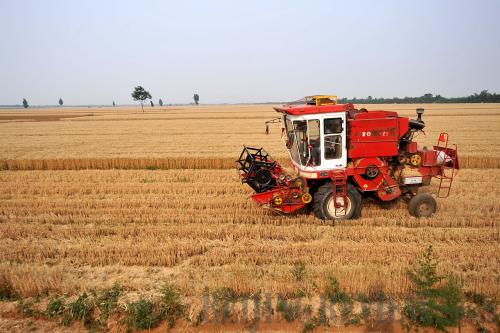|
 |
|
HARVEST SEASON: A reaper gathers wheat in a village in Yuncheng, Shanxi Province, on June 4 (ZHAN YAN) |
Following the launch of several economic development zones in north, south, east and west China, the Central Government has set its sights on plans to develop the country's Central Plains region.
On December 3, the National Development and Reform Commission (NDRC) released on its website the Development Plan for the Central Plains Economic Zone (2012-20), which encompasses Henan and parts of Hebei, Shanxi, Anhui and Shandong provinces, covering as much as 289,000 square km or 3 percent of China's land area. At the end of 2011, the region's population totaled 179 million, or 13.3 percent of the nation's total. Its output amounted to 4.2 trillion yuan ($672.4 billion) or 9 percent of the nation's GDP.
"The Central Plains Economic Zone is the largest in area and most populated zone. It is fourth only to the Yangtze River Delta, Pearl River Delta and Beijing-Tianjin-Hebei Economic Zone in terms of aggregate economic volume and plays a significant role in China's reforms and development," said Chen Dongsheng, Vice Chairman of the China Association of Regional Economies.
More importantly, the Central Plains are considered China's "great granary," contributing 18 percent to the nation's total grain output and 50 percent of its total wheat output.
"One fourth of the noodles on our dinner table come from the region. Without food security guaranteed by the Central Plains, social unrests may arise," said Chen. He said that if the region can find a coordinated way to undergo urbanization, industrialization and agricultural modernization without compromising agricultural development, food security and the health of the environment, the region's development would set an excellent example for future development in the country.
According to the plan, the Central Government will build the Central Plains Economic Zone into an important base for agriculture, developing it as a new model for industrialization, urbanization and modernization.
Traditionally, the Central Plains were largely focused on agriculture, especially in Henan Province, which has the largest agricultural population in China, said Chen Yao, a research fellow from the Institute of Industrial Economics of the Chinese Academy of Social Sciences. To create more jobs and support urbanization, Henan needs to step up its industrialization.
China's trajectory toward modernization has been fraught with major problems, including less farmland, lower grain output and environment degradation, all issues the development of the Central Plains must tackle. The region's development must proceed down a "harmonious" path in its "industrialization and urbanization," said Chen Yao.
Xiao Jincheng, Director of the Research Institute of Territorial Development and Regional Economics at the NDRC, said that urbanization will be a major factor in the development of the Central Plains and city clusters have taken shape down the road.
Today, the enlargement of cities has become a marker of urbanization in the developed world due to their dense population and employment opportunities, often morphing into zones for further economic development.
Xiao said that while city clusters take hold, industrialization should be strengthened to spur more people to migrate from rural to urban areas. Only when the rural population has dwindled can intensive production be realized in the agricultural sector.
The Central Plains region boasts a distinct advantage in transportation: Almost all the key transport hubs connecting the entire country are located here. By the end of 2011, the length of railways in operation and highway traffic mileage had hit 6,965 km and 8,323 km, accounting for 7 and 9.8 percent of the country's total, respectively.
With seven airports in operation, air transportation is also well developed in the zone. According to the plan, the zone will further construct an asterisk-shaped traffic network with Zhengzhou, capital of Henan.
Another promise for the region's development is its large population could significantly enhance its industrialization and agricultural modernization.
"The plan suggests boosting the zone's urbanization rate to 56 percent by 2020," said Xiao. "The goal is within our reach."
| 